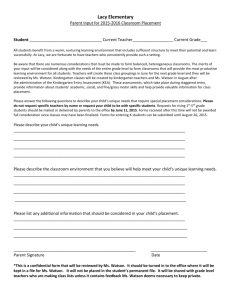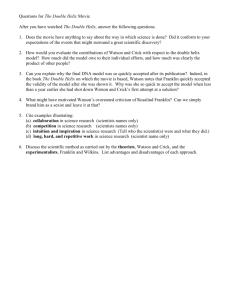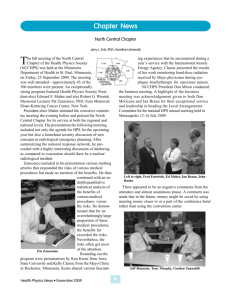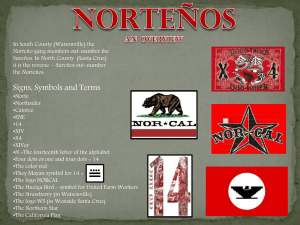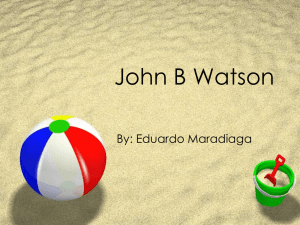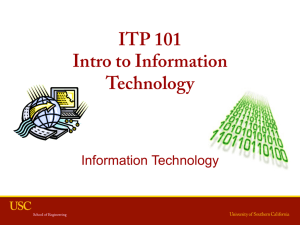CS 548 KNOWLEDGE DISCOVERY AND DATA MINING
advertisement
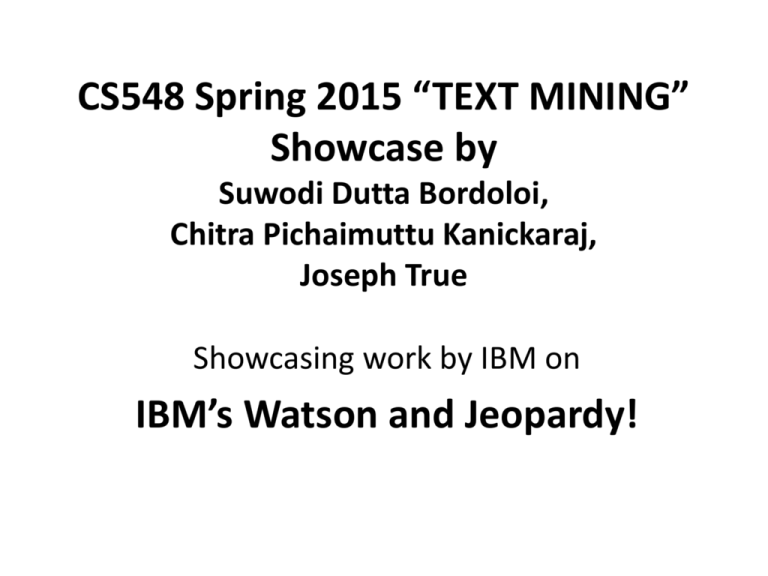
CS548 Spring 2015 “TEXT MINING” Showcase by Suwodi Dutta Bordoloi, Chitra Pichaimuttu Kanickaraj, Joseph True Showcasing work by IBM on IBM’s Watson and Jeopardy! References 1. D. A. Ferrucci, “Introduction: This Is Watson”, in IBM Journal of Research and Development, Vol. 56, No. ¾, Paper 1, May/July 2012. 2. A. Lally et al., “Question Analysis : How Watson Reads A Clue”, in IBM Journal of Research and Development, Vol. 56, No. ¾, Paper 2, May/July 2012 3. M. C. Mccord et al., “Deep Parsing In Watson”, in IBM Journal of Research and Development, Vol. 56, No. ¾, Paper 3, May/July 2012. 4. J. Chu-carroll et al., “Textual Resource Acquisition And Engineering”, in IBM Journal Of Research And Development, Vol. 56, No. ¾, Paper 4, May/July 2012. 5. J. W. Murdock et al., “Textual Evidence Gathering And Analysis”, in IBM Journal of Research and Development, Vol. 56, No. ¾, Paper 8, May/July 2012. 6. D. C. Gondek et al., “A Framework For Merging And Ranking Answers In DeepQA”, in IBM Journal of Research and Development, Vol. 56, No. ¾, Paper 14, May/July 2012. IBM Journal of Research and Development This is Watson May-July 2012 03 - Introduction-This is Watson 04 - Question analysis How Watson reads a clue 05 - Deep parsing in Watson 06 - Textual resource acquisition 07 - Automatic knowledge extraction from documents 08 - Finding needles in the haystack Search and candidate generation 09 – Typing candidate answers using type coercion 10 - Textual evidence gathering and analysis 11 - Relation extraction and scoring in DeepQA 12 - Structured data and inference in DeepQA 13 - Special Questions and techniques 14 - Identifying implicit relationships 15 - Fact-based question decomposition in DeepQA 16 - A framework for merging and ranking of answers in DeepQA 17 - Making Watson fast 18 - Simulation-learning-and-optimization-techniques-in-Watsons-gamestrategies 19 -In the game-The interface between Watson and Jeopardy What is Jeopardy! ? • TV game quiz show • 1964 debut • 50 years • 6000+ episodes • Questions: history, current events, science, arts, popular culture, literature … http://en.wikipedia.org/wiki/Jeopardy! Jeopardy! Question Example Question: • Located in central Massachusetts, this school is one of the first engineering and technology universities in the United States. Answer: • What is WPI? What is Watson? What is Watson? • Computer system built to play Jeopardy! quiz game with humans • Open-domain question-answering (QA) • Developed 2007 – 2010 • 2011: Watson v. Jeopardy! champion winners • Brad Rutter • Biggest all-time money winner • $4 million • Never lost against a human • Ken Jennings • Record longest winning streak • 74 games in a row Watson System Hardware: • • • Cluster of 90 IBM Power 750 servers 16 terabytes of RAM Process 500 gigabytes per second (= 1 million books) Software: • • • • IBM's DeepQA software Apache UIMA (Unstructured Information Management Architecture) framework SUSE Linux Enterprise Server 11 OS Apache Hadoop (distributed computing) What’s the big deal? Real Language is … Really Hard • Chess – – – – Finite, mathematically well-defined search space Limited number of moves and states Grounded in explicit, unambiguous mathematical rules IBM Deep Blue - chess computer v. world champion (1997) • Human Language – Ambiguous, contextual and implicit – Grounded only in human cognition – Seemingly infinite number of ways to express the same meaning Source: IBM Watson A Brief Overview and Thoughts for Healthcare Education and Performance Improvement How to win? 85% Precision@70 (85% Precision at 70% answered) • Buzz in for >= 70% of questions • Answer correctly >= 85% 3 seconds (on average) • • • • • Parse the question Understand what it was asking for Relate question and meaning to available data Determine the best answer Compute confidence: buzz in or not? Text Mining and Related Technologies Why? Expand research in open domain QA … processing of language and knowledge Many areas of computer science and AI (and Text Mining & Text Analytics) • Natural language processing (NLP) • Information retrieval (IR) • Knowledge representation and reasoning (KR&R) • Automated reasoning • Machine learning Architecture: • Apache UIMA (Unstructured Information Management Architecture) framework to support collection of data and apply analytics, algorithms … • IBM DeepQA – extensible architecture for building QA systems Data Sources • Not connected to the Internet during the game • 200 million pages of structured and unstructured reference material • 4 terabytes of disk storage Sources of information: • Full text of Wikipedia • Encyclopedias • Dictionaries • Thesauri • Newswire articles • Literary works • Other databases, taxonomies, and ontologies. (DBPedia, WordNet, and Yago) Data Collection Sources: Acquire --> Transform --> Expand • Get info. with good coverage (for Jeopardy questions) • Extract info into format for system • Get more info. - increase coverage per topic Data Processing • Automatically extract knowledge from documents • Assemble structured knowledge from unstructured data How does Watson Answer a Question? Four Steps: 1. Question Analysis 2. Hypothesis Generation 3. Hypothesis and Evidence Scoring 4. Final Merging and Ranking Foundation of Question Analysis • Unstructured text Input Parsing & Analysis Output • Identifies syntactic and semantic elements of the question • Structured information which is later used by other components of Watson GOAL: Identify critical elements of the question by applying numerous detection rules and classifiers based on this foundation. Step 1: Question Analysis Elements of Question Analysis are: 1. Focus detection Part of the question that is the reference to the answer. 2. Lexical Answer Types (LATs) Strings in the clue that indicate what type of entity is being asked for 3. Question Classification Logical categorization of question in definite class to narrow down the scope of search. Example: Why, Definition, Fact 4. Question decomposition Breaking question in the logical sub parts Question Analysis POETS & POETRY: He was a bank clerk in the Yukon before he published Songs of a Sourdough in 1907. Lexical Analysis Type (LAT) Focus Category : Fact FICTIONAL ANIMALS: The name of this character, introduced in 1894, comes from the Hindi for bear. (Answer: Baloo). → Sub-question 1: Find the characters introduced in 1894. → Sub-question 2: Find the words that come from hindi for bear. Evidence for both of the sub-questions are combined for Scoring. Source: QA System & Watson by Bansal, De and Nishat Parsing & Semantic Analysis Suite 1. Slot Grammar parser ESG (English Slot Grammar) 3. Co-reference Resolution Component 4 .Relation Extraction Component Parsing And Semantic Analysis 2. Predicateargument Structure (PAS) 5. Named Entity Recognizer (NER) – Provides an analytical structure of questions posed and textual knowledge. Source: QA System & Watson by Bansal, De and Nishat English Slot Grammer (ESG) parser Deep parser which explores the syntactic and logical structure to generate semantic clues subj obj Slots WS(arg) features Subj(n) John(1) noun pron Top sold(2,1,4) verb Ndet a(3) det indef Obj(n) fish(4) noun ndet John sold a fish Fig: Slot filling for John sold a fish Fig: Slot Grammer Analysis Structure Source: QA System & Watson by Bansal, De and Nishat Predicate-Argument Structure (PAD) builder Modifies the output of the ESG parse. Example: “John sold a fish” and “A fish was sold by John” yield different parse trees via ESG but reduce to the same PAS. John(1) Sold(2, subj:1, obj:4) a(3) fish(4,ndet:3) [determiner : a] Figure: PAS Builder Source: QA System & Watson by Bansal, De and Nishat Parsing And Semantic Analysis (Cont..) Example POETS & POETRY: He was a bank clerk in the Yukon before he published “Songs of a Sourdough” in 1907. 3. Co-reference Resolution Component – the two occurrences of “he” and “clerk” 4. Relation Extraction Component – identify semantic relationships among entities – authorOf(focus, ‘‘Songs of a Sourdough’’) 5. Named Entity Recognizer (NER) Person: Mr. Hubert J. Smith, Adm. McInnes, Grace Chan Title: Chairman, Vice President of Technology, Secretary of State Country: USSR, France, Haiti, Haitian Republic – People: He Step 2: Hypothesis generation • Process of producing possible answers to a given question. • Two main components : – Search • Retrieve relevant content from its diverse knowledge source – Candidate generation • Identifies the potential answers Source: IBM Watson A Brief Overview and Thoughts for Healthcare Education and Performance Improvement Step 3: Evidence Scoring • Need to support and defend the candidate answers • Watson – collects passages from many different sources – Understands relations between the passages – Scores evidence on the quality of the passage using different algorithms – Thousands of passages are scored in a few seconds! Support Evidence Retrieval • Inserts candidate answer back into the original question to form a proposition - find passages most closely related to that proposition. • E.g.: “In 1840 this German romantic married Clara Wieck, an outstanding pianist and a composer, too.” • E.g. candidate Answer (low score) : “Clara Wieck Schumann: a German musician, one of the leading pianists of the Romantic era, as well as a composer, and wife of composer Robert Schumann.” Support Evidence Retrieval (cont.) • Our passage scorers need to know that ‘wife’ relates to ‘married’ • SER forms a query that includes the required phrase Robert Schumann along with other terms from the answer, such as 1840, German, romantic, pianist, Clara Wieck, and composer • Result: more passages, high score (in-spite of missing original terms) “Although Robert Schumann made some symphonic attempts in the autumn of 1840, soon after he married his beloved Clara Wieck, he did not compose the symphony until early 1841” Evidence Scoring Algorithms “Passage Term Match” • How often a candidate answer appears in the same passages as the question terms – Passages that do not specifically answer the question but just reflect some co-occurrence • E.g.: A passage that states that Robert Schumann and Clara Wieck traveled together – does not prove or imply that the two were married – but statistically having more passages that include the two of them is correlated with them being married. Evidence Scoring Algorithms “Passage Term Match” (cont.) • Evaluation: – Question terms t1 . . . tn are extracted – For each passage, a score pi is computed as the sum of inverse document frequency (idf) values of matching terms – idf used because not all tokens are equally important • Weakness: Too aggressive, assigning too much credit answers closely related to question terms Evidence Scoring Algorithms “Skip Bigram” • How many pairs of terms from a question and a passage match? • The scorer attempts to match pairs of terms that are linked directly in a structural graph or indirectly through only one intermediate node • Scorer is largely a measure of co-occurrence – Determines the extent to which the answer appears in passages with words from the clue – Specifically focuses on whether those words are close to each other in the syntactic–semantic graph (built from parsing) Evidence Scoring Algorithms “Skip Bigram” (cont.) • E.g.: “Who invented the motor driven phonograph? • Give credit to passages that discuss motor driven phonograph, phonograph driven by a motor, motor driving a phonograph, etc. • No credit for passages that mention motors, driving, and phonographs in separate sentences or clauses. Thus ignore some passages that Passage Term Match awards a high score to. Step 4: Final Merging and Ranking • Different types of evidence supports different types of questions • Watson uses it’s experience (like a person!) to answer similar questions in order to weigh the evidence • By playing thousands of practice games, Watson learns to weigh, apply and combine each piece of evidence • Weighted evidence scores are used to decide the final scores for each answer. Each answer has a confidence (based on it’s score) • Low score – Watson doesn’t answer! (depending on the threshold w.r.t other competitors) Future Directions Apply technology to: • Health Care • (Medical Journals, patient history and records, dr’s notes …) • • • • Finance Retail Education Or any other industry using unstructured data
